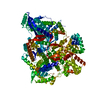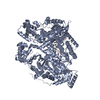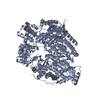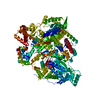+ Open data
Open data
- Basic information
Basic information
| Entry | Database: PDB / ID: 8qhd | ||||||
|---|---|---|---|---|---|---|---|
| Title | Hantaan virus polymerase in hexameric state | ||||||
 Components Components | RNA-directed RNA polymerase L | ||||||
 Keywords Keywords | VIRAL PROTEIN / Bunyavirus / Hantaan virus / polymerase / dimer | ||||||
| Function / homology |  Function and homology information Function and homology informationRNA-templated viral transcription / negative stranded viral RNA replication / cap snatching / endonuclease activity / Hydrolases; Acting on ester bonds / host cell perinuclear region of cytoplasm / RNA-directed RNA polymerase / nucleotide binding / RNA-directed RNA polymerase activity / DNA-templated transcription / metal ion binding Similarity search - Function | ||||||
| Biological species |  Hantaan virus 76-118 Hantaan virus 76-118 | ||||||
| Method | ELECTRON MICROSCOPY / single particle reconstruction / cryo EM / Resolution: 3.6 Å | ||||||
 Authors Authors | Durieux Trouilleton, Q. / Arragain, B. / Malet, H. | ||||||
| Funding support |  France, 1items France, 1items
| ||||||
 Citation Citation |  Journal: Nat Commun / Year: 2024 Journal: Nat Commun / Year: 2024Title: Structural characterization of the oligomerization of full-length Hantaan virus polymerase into symmetric dimers and hexamers. Authors: Quentin Durieux Trouilleton / Dominique Housset / Paco Tarillon / Benoît Arragain / Hélène Malet /  Abstract: Hantaan virus is a dangerous human pathogen whose segmented negative-stranded RNA genome is replicated and transcribed by a virally-encoded multi-functional polymerase. Here we describe the complete ...Hantaan virus is a dangerous human pathogen whose segmented negative-stranded RNA genome is replicated and transcribed by a virally-encoded multi-functional polymerase. Here we describe the complete cryo-electron microscopy structure of Hantaan virus polymerase in several oligomeric forms. Apo polymerase protomers can adopt two drastically different conformations, which assemble into two distinct symmetric homodimers, that can themselves gather to form hexamers. Polymerase dimerization induces the stabilization of most polymerase domains, including the C-terminal domain that contributes the most to dimer's interface, along with a lariat region that participates to the polymerase steadying. Binding to viral RNA induces significant conformational changes resulting in symmetric oligomer disruption and polymerase activation, suggesting the possible involvement of apo multimers as protecting systems that would stabilize the otherwise flexible C-terminal domains. Overall, these results provide insights into the multimerization capability of Hantavirus polymerase and may help to define antiviral compounds to counteract these life-threatening viruses. | ||||||
| History |
|
- Structure visualization
Structure visualization
| Structure viewer | Molecule:  Molmil Molmil Jmol/JSmol Jmol/JSmol |
|---|
- Downloads & links
Downloads & links
- Download
Download
| PDBx/mmCIF format |  8qhd.cif.gz 8qhd.cif.gz | 2 MB | Display |  PDBx/mmCIF format PDBx/mmCIF format |
|---|---|---|---|---|
| PDB format |  pdb8qhd.ent.gz pdb8qhd.ent.gz | 1.7 MB | Display |  PDB format PDB format |
| PDBx/mmJSON format |  8qhd.json.gz 8qhd.json.gz | Tree view |  PDBx/mmJSON format PDBx/mmJSON format | |
| Others |  Other downloads Other downloads |
-Validation report
| Summary document |  8qhd_validation.pdf.gz 8qhd_validation.pdf.gz | 898.3 KB | Display |  wwPDB validaton report wwPDB validaton report |
|---|---|---|---|---|
| Full document |  8qhd_full_validation.pdf.gz 8qhd_full_validation.pdf.gz | 1.1 MB | Display | |
| Data in XML |  8qhd_validation.xml.gz 8qhd_validation.xml.gz | 293.5 KB | Display | |
| Data in CIF |  8qhd_validation.cif.gz 8qhd_validation.cif.gz | 436.2 KB | Display | |
| Arichive directory |  https://data.pdbj.org/pub/pdb/validation_reports/qh/8qhd https://data.pdbj.org/pub/pdb/validation_reports/qh/8qhd ftp://data.pdbj.org/pub/pdb/validation_reports/qh/8qhd ftp://data.pdbj.org/pub/pdb/validation_reports/qh/8qhd | HTTPS FTP |
-Related structure data
| Related structure data |  18408MC  8qe5C  8qgtC  8qguC  8qh3C C: citing same article ( M: map data used to model this data |
|---|---|
| Similar structure data | Similarity search - Function & homology  F&H Search F&H Search |
| Experimental dataset #1 | Data reference:  10.15151/ESRF-ES-1251041225 / Data set type: other data 10.15151/ESRF-ES-1251041225 / Data set type: other data |
- Links
Links
- Assembly
Assembly
| Deposited unit | 
|
|---|---|
| 1 |
|
- Components
Components
| #1: Protein | Mass: 249476.484 Da / Num. of mol.: 6 Source method: isolated from a genetically manipulated source Source: (gene. exp.)  Hantaan virus 76-118 / Production host: Hantaan virus 76-118 / Production host:  Trichoplusia ni (cabbage looper) / References: UniProt: P23456 Trichoplusia ni (cabbage looper) / References: UniProt: P23456 |
|---|
-Experimental details
-Experiment
| Experiment | Method: ELECTRON MICROSCOPY |
|---|---|
| EM experiment | Aggregation state: PARTICLE / 3D reconstruction method: single particle reconstruction |
- Sample preparation
Sample preparation
| Component | Name: Hantaan virus polymerase / Type: COMPLEX / Entity ID: all / Source: RECOMBINANT | ||||||||||||||||||||
|---|---|---|---|---|---|---|---|---|---|---|---|---|---|---|---|---|---|---|---|---|---|
| Molecular weight | Value: 1.5 MDa / Experimental value: NO | ||||||||||||||||||||
| Source (natural) | Organism:  Hantaan virus 76-118 Hantaan virus 76-118 | ||||||||||||||||||||
| Source (recombinant) | Organism:  Trichoplusia ni (cabbage looper) Trichoplusia ni (cabbage looper) | ||||||||||||||||||||
| Buffer solution | pH: 8 | ||||||||||||||||||||
| Buffer component |
| ||||||||||||||||||||
| Specimen | Conc.: 0.25 mg/ml / Embedding applied: NO / Shadowing applied: NO / Staining applied: NO / Vitrification applied: YES | ||||||||||||||||||||
| Specimen support | Details: 25 mA / Grid material: GOLD / Grid mesh size: 300 divisions/in. / Grid type: UltrAuFoil R1.2/1.3 | ||||||||||||||||||||
| Vitrification | Instrument: FEI VITROBOT MARK IV / Cryogen name: ETHANE / Humidity: 100 % / Chamber temperature: 77 K / Details: blot force 1 3s |
- Electron microscopy imaging
Electron microscopy imaging
| Experimental equipment |  Model: Titan Krios / Image courtesy: FEI Company |
|---|---|
| Microscopy | Model: FEI TITAN KRIOS |
| Electron gun | Electron source:  FIELD EMISSION GUN / Accelerating voltage: 300 kV / Illumination mode: FLOOD BEAM FIELD EMISSION GUN / Accelerating voltage: 300 kV / Illumination mode: FLOOD BEAM |
| Electron lens | Mode: BRIGHT FIELD / Nominal magnification: 105000 X / Calibrated magnification: 105000 X / Nominal defocus max: 2000 nm / Nominal defocus min: 800 nm / Calibrated defocus min: 800 nm / Calibrated defocus max: 2000 nm / Alignment procedure: COMA FREE |
| Specimen holder | Cryogen: NITROGEN / Specimen holder model: FEI TITAN KRIOS AUTOGRID HOLDER |
| Image recording | Average exposure time: 1.45 sec. / Electron dose: 40 e/Å2 / Film or detector model: GATAN K3 (6k x 4k) / Num. of grids imaged: 1 / Num. of real images: 14650 |
| EM imaging optics | Energyfilter name: GIF Quantum LS / Energyfilter slit width: 20 eV |
| Image scans | Width: 5760 / Height: 4092 |
- Processing
Processing
| EM software |
| ||||||||||||||||||||||||||||||||||||||||||||||||||
|---|---|---|---|---|---|---|---|---|---|---|---|---|---|---|---|---|---|---|---|---|---|---|---|---|---|---|---|---|---|---|---|---|---|---|---|---|---|---|---|---|---|---|---|---|---|---|---|---|---|---|---|
| CTF correction | Type: PHASE FLIPPING AND AMPLITUDE CORRECTION | ||||||||||||||||||||||||||||||||||||||||||||||||||
| Particle selection | Num. of particles selected: 3354153 | ||||||||||||||||||||||||||||||||||||||||||||||||||
| Symmetry | Point symmetry: C2 (2 fold cyclic) | ||||||||||||||||||||||||||||||||||||||||||||||||||
| 3D reconstruction | Resolution: 3.6 Å / Resolution method: FSC 0.143 CUT-OFF / Num. of particles: 28695 Details: This is a chimeric map of Hantaan polymerase hexamer. It originates from the global map in which the tow internal protomers are defined and a focused map that comprises one internal protomer ...Details: This is a chimeric map of Hantaan polymerase hexamer. It originates from the global map in which the tow internal protomers are defined and a focused map that comprises one internal protomer and two external protomers. The chimeric map has a C2 symmetry Symmetry type: POINT | ||||||||||||||||||||||||||||||||||||||||||||||||||
| Atomic model building | Protocol: AB INITIO MODEL / Space: REAL | ||||||||||||||||||||||||||||||||||||||||||||||||||
| Atomic model building | PDB-ID: 8C4S Pdb chain-ID: A / Accession code: 8C4S / Source name: PDB / Type: experimental model |
 Movie
Movie Controller
Controller












 PDBj
PDBj
